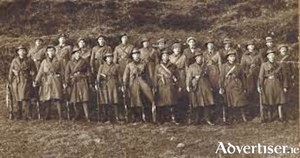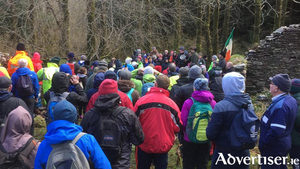Search Results for 'Michael Kilroy'
5 results found.
Wild nights of burning and murder

Clifden was not the only town to experience the terror of British forces running wild, shooting, and setting fire to buildings. The previous year, July 19 1920, Tuam suffered a similar experience as Clifden, only mercifully no resident was killed on that occasion.
Mayo through Jack Leonard’s lense

'The Men of the West', that iconic photograph of Michael Kilroy's flying column taken with only the aid of natural light on the southern slopes of Nephin at 11.45pm on the longest day of the year in 1921, is known to us all. It hangs in numerous Mayo pubs and homes and thanks to the quality of the conditions and the skill of the photographer, we can clearly see the resolute expressions of the young men, we know their names and know their stories. But what of the photographer himself? What of the man who captured this first ever photo of an IRA unit on active service in Ireland? Jack Leonard did not just happen upon Kilroy and his men that bright June night. He was no amateur photographer, and neither was he a bystander during his country's fight for freedom. With a keen sense of duty, Leonard used his talent to capture all aspects of Mayo life in the early twentieth century. Jack 'JJ' Leonard was born in 1882 in Crossmolina and as a young man he trained in journalism and photography in London. He returned to Ireland in 1906 to set up his photography business at a time when the country was in political flux. Emotions and anger remained after the Land War in Mayo, a period of civil unrest and violence in the late 1800s, and the methods of parliamentary nationalists were now being challenged by physical force republicans.
Mayo through Jack Leonard’s lens

'The Men of the West', that iconic photograph of Michael Kilroy's flying column taken with only the aid of natural light on the southern slopes of Nephin at 11.45pm on the longest day of the year in 1921, is known to us all. It hangs in numerous Mayo pubs and homes and thanks to the quality of the conditions and the skill of the photographer, we can clearly see the resolute expressions of the young men, we know their names and know their stories. But what of the photographer himself? What of the man who captured this first ever photo of an IRA unit on active service in Ireland? Jack Leonard did not just happen upon Kilroy and his men that bright June night. He was no amateur photographer, and neither was he a bystander during his country's fight for freedom. With a keen sense of duty, Leonard used his talent to capture all aspects of Mayo life in the early twentieth century. Jack 'JJ' Leonard was born in 1882 in Crossmolina and as a young man he trained in journalism and photography in London. He returned to Ireland in 1906 to set up his photography business at a time when the country was in political flux. Emotions and anger remained after the Land War in Mayo, a period of civil unrest and violence in the late 1800s, and the methods of parliamentary nationalists were now being challenged by physical force republicans.
Large crowds turn out on Easter Monday for Trek to Freedom walk

On Easter Monday, a large contingent of walkers and history enthusiasts departed from Newport to follow in the footsteps of Michael Kilroy's flying column, who during the War of Indepdence escaped through the mountains and countryside of Newport following an ambush in Kilmeena. The day started in upper Skirdagh where Niamh Chambers read the Proclamation followed by Billy Chambers' account of the West Mayo Flying Column. Then it was on to the now ruins of what was in their day the safe houses, where Michael Kilroy's men rested after the Kilmeanna ambush. Here Patrick Carey told the group about the people who once lived here and the men they looked after.
Hike to freedom this Easter Sunday

This Easter Monday at 10am the Nephin Beggars Hill Walking group and the Wild Nephin Mountains Group will be taking a trip back in time to May 1921 to the aftermath of the Kilmeanna ambush where Michael Kilroy's West Mayo flying column retreated to the safety of the Nephin mountains after an attack on a large force of British soldiers.

